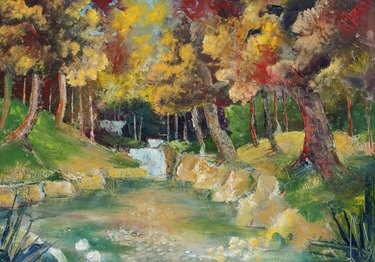
Cleaning paintbrushes with turpentine is a basic skill every painter needs to know. Regardless of the painting medium, paintbrush care is of the utmost importance – paint residue left in a brush may rear its ugly head and find its way onto your masterpiece. A clean paintbrush may be the difference between a vibrant painting and a horrible mistake on canvas.
What You'll Need
Video of the Day
Cleaning a paintbrush with turpentine is easy – all it requires is a dirty paintbrush, newspaper, a jar with lid to hold the turpentine (jar size depends on the brush size), turpentine, dish soap, warm water, a towel and optional wire brush or fingernail brush. The turpentine-cleaning method works best for brushes used with oil-based, acrylic, latex and enamel paints. Most water-based paints clean easily with warm water and soap. For stuck-on paint of all types, a soak in turpentine might just do the trick.
Video of the Day
Cleaning a Wet Brush
Remove the excess paint from the paintbrush. Carefully wrap the brush in newspaper and squeeze the bristles from the ferrule to the tip. This removes loose paint hidden within the fibers. Next, fill a container half full of turpentine. Place the brush in the liquid and carefully swish it around. Press the bristles against the side of the container to thoroughly work the turpentine into the brush. Repeat this step until most of the paint is gone.
Some paint may still color the bristles, but that's OK. Wash the brush with dish soap and warm water to remove the turpentine and the remaining paint. Pat the brush with a towel to remove the moisture and allow the brush to air dry on a horizontal surface. Seal the turpentine container for later use and store it in a safe place.
Cleaning a Semi-dry Brush
The best time to clean a brush is immediately after it has been used, however, there is hope for a brush that is semi-dry. Soak the brush in the turpentine for 30 minutes to an hour to loosen the dried paint. Use a wire brush or fingernail brush and gently work the paint from the bristles. If necessary, allow the brush to soak for another 30 minutes to an hour, and then clean it following the procedure for a wet brush.
Safety Precautions
Turpentine is a chemical with a pungent odor, and it may trigger breathing issues in some people and cause skin reactions. Always use turpentine in a well-ventilated area. If you're prone to breathing problems wear a mask, and wear gloves to prevent skin irritation. If you get turpentine on your skin, wash the area with soap and water. Store turpentine out of the reach of children.